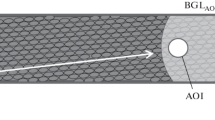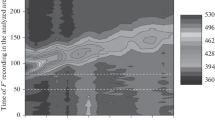Abstract
Local illumination of the characean internode with a 30-s pulse of white light was found to induce the delayed transient increase of modulated chlorophyll fluorescence in shaded cell parts, provided the analyzed region is located downstream in the cytoplasmic flow at millimeter distances from the light spot. The fluorescence response to photostimulation of a remote cell region indicates that the metabolites produced by source chloroplasts in an illuminated region are carried downstream with the cytoplasmic flow, thus ensuring long-distance communications between anchored plastids in giant internodal cells. The properties of individual stages of metabolite signaling are not yet well known. We show here that the export of assimilates and/or reducing equivalents from the source chloroplasts into the flowing cytoplasm is largely insensitive to the direction of plasma-membrane H+ flows, whereas the events in sink regions where these metabolites are delivered to the acceptor chloroplasts under dim light are controlled by H+ fluxes across the plasma membrane. The fluorescence response to local illumination of remote cell regions was best pronounced under weak background light and was also observed in a modified form within 1–2 min after the transfer of cell to darkness. The fluorescence transients in darkened cells were suppressed by antimycin A, an inhibitor of electron transfer from ferredoxin to plastoquinone, whereas the fluorescence response under background light was insensitive to this inhibitor. We conclude that the accumulation of reduced metabolites in the stroma leads to the reduction of photosystem II primary quinone acceptor (QA) via two separate (photochemical and non-photochemical) pathways.










Similar content being viewed by others
Abbreviations
- AOI:
-
Area of inspection
- BGL:
-
Background light
- LL:
-
Local light (illumination)
- PFD:
-
Photon flux density
- pHo :
-
pH on cell surface
- PQ:
-
Plastoquinone
- PSI:
-
Photosystem I
- PSII:
-
Photosystem II
References
Beilby MJ, Casanova MT (2014) The physiology of characean cells. Springer, Berlin
Bendall DS, Manasse RS (1995) Cyclic photophosphorylation and electron transport. Biochim Biophys Acta 1229:23–38
Bulychev AA (2012) Membrane excitation and cytoplasmic streaming as modulators of photosynthesis and proton flows in characean cells. In: Volkov AG (ed) Plant electrophysiology: methods and cell electrophysiology. Springer, Berlin, pp 273–300. https://doi.org/10.1007/978-3-642-29119-7_12
Bulychev AA, Dodonova SO (2011) Effects of cyclosis on chloroplast–cytoplasm interactions revealed with localized lighting in characean cells at rest and after electrical excitation. Biochim Biophys Acta 1807:1221–1230. https://doi.org/10.1016/j.bbabio.2011.06.009
Bulychev AA, Foissner I (2017) Pathways for external alkalinization in intact and in microwounded Chara cells are differentially sensitive to wortmannin. Plant Signal Behav 12:e1362518. https://doi.org/10.1080/15592324.2017.1362518
Bulychev AA, Komarova AV (2015) Photoinduction of cyclosis-mediated interactions between distant chloroplasts. Biochim Biophys Acta 1847:379–389. https://doi.org/10.1016/j.bbabio.2015.01.004
Bulychev AA, Komarova AV (2017a) Implication of long-distance cytoplasmic transport into dynamics of local pH on the surface of microinjured Chara cells. Protoplasma 254:557–567. https://doi.org/10.1007/s00709-016-0975-x
Bulychev AA, Komarova AV (2017b) Photoregulation of photosystem II activity mediated by cytoplasmic streaming in Chara and its relation to pH bands. Biochim Biophys Acta 1858:386–395. https://doi.org/10.1016/j.bbabio.2017.02.014
Bulychev AA, Alova AV, Rubin AB (2013) Propagation of photoinduced signals with the cytoplasmic flow along characean internodes: evidence from changes in chloroplast fluorescence and surface pH. Eur Biophys J 42:441–453. https://doi.org/10.1007/s00249-013-0895-z
Carrillo N, Ceccarelli EA (2003) Open questions in ferredoxin-NADP+ reductase catalytic mechanism. Eur J Biochem 270:1900–1915. https://doi.org/10.1046/j.1432-1033.2003.03566.x
Carrillo N, Lucero HA, Vallejos RH (1981) Light modulation of chloroplast membrane-bound ferredoxin-NADP+ oxidoreductase. J Biol Chem 256:1058–1059
Choi W-G, Hilleary R, Swanson SJ, Kim S-H, Gilroy S (2016) Rapid, long-distance electrical and calcium signaling in plants. Annu Rev Plant Biol 67:287–307. https://doi.org/10.1146/annurev-arplant-043015-112130
Corneille S, Cournac L, Guedeney G, Havaux M, Peltier G (1998) Reduction of the plastoquinone pool by exogenous NADH and NADPH in higher plant chloroplasts: characterization of a NAD(P)H–plastoquinone oxidoreductase activity. Biochim Biophys Acta 1363:59–69
Dodonova SO, Bulychev AA (2011) Cyclosis-related asymmetry of chloroplast–plasma membrane interactions at the margins of illuminated area in Chara corallina cells. Protoplasma 248:737–749. https://doi.org/10.1007/s00709-010-0241-6
Endo T, Mi H, Shikanai T, Asada K (1997) Donation of electrons to plastoquinone by NAD(P)H dehydrogenase and by ferredoxin-quinone reductase in spinach chloroplasts. Plant Cell Physiol 38:1272–1277
Endo T, Shikanai T, Sato F, Asada K (1998) NAD(P)H dehydrogenase-dependent, antimycin A-sensitive electron donation to plastoquinone in tobacco chloroplasts. Plant Cell Physiol 39:1226–1231
Feijó JA, Sainhas J, Hackett GR, Kunkel JG, Hepler PK (1999) Growing pollen tubes possess a constitutive alkaline band in the clear zone and a growth-dependent acidic tip. J Cell Biol 144:483–496
Flügge UI, Gerber J, Heldt HW (1983) Regulation of the reconstituted chloroplast phosphate translocator by an H+ gradient. Biochim Biophys Acta 725:229–237
Foissner I, Wasteneys GO (2007) Wide-ranging effects of eight cytochalasins and latrunculin A and B on intracellular motility and actin filament reorganization in characean internodal cells. Plant Cell Physiol 48:585–597. https://doi.org/10.1093/pcp/pcm030
Foyer CH, Neukermans J, Queval G, Noctor G, Harbinson J (2012) Photosynthetic control of electron transport and the regulation of gene expression. J Exp Bot 63:1637–1661. https://doi.org/10.1093/jxb/ers013
Goldstein RE, van de Meent J-W (2015) A physical perspective on cytoplasmic streaming. Interface Focus 5:20150030. https://doi.org/10.1098/rsfs.2015.0030
Hauser M, Eichelmann H, Oja V, Heber U, Laisk A (1995) Stimulation by light of rapid pH regulation in the chloroplast stroma in vivo as indicated by CO2 solubilization in leaves. Plant Physiol 108:1059–1066
Hochachka PW (1999) The metabolic implications of intracellular circulation. Proc Natl Acad Sci U S A 96:12233–12239
Kiss JZ (1997) Gravitropism in the rhizoids of the alga Chara: a model system for microgravity research. Biol Bull 192:134–136
Komarova AV, Sukhov VS, Bulychev AA (2018) Cyclosis-mediated long distance communications of chloroplasts in giant cells of Characeae. Funct Plant Biol 45:236–246. https://doi.org/10.1071/FP16283
Mano J, Miyake C, Schreiber U, Asada K (1995) Photoactivation of the electron flow from NADPH to plastoquinone in spinach chloroplasts. Plant Cell Physiol 36:1589–1598
Munekage Y, Hashimoto M, Miyake C, Tomizawa K-I, Endo T, Tasaka M, Shikanai T (2004) Cyclic electron flow around photosystem I is essential for photosynthesis. Nature 429:579–582
Mus F, Cournac L, Cardettini V, Caruana A, Peltier G (2005) Inhibitor studies on non-photochemical plastoquinone reduction and H2 photoproduction in Chlamydomonas reinhardtii. Biochim Biophys Acta 1708:322–332. https://doi.org/10.1016/j.bbabio.2005.05.003
Pearcy RW, Krall JP, Sassenrath-Cole GF (1996) Photosynthesis in fluctuating light environments. In: Baker NR (ed) Photosynthesis and the environment. Kluwer, Dordrecht, pp 321–346
Pickard WF (2003) The role of cytoplasmic streaming in symplastic transport. Plant Cell Environ 26:1–15
Plieth C, Tabrizi H, Hansen U-P (1994) Relationship between banding and photosynthetic activity in Chara corallina as studied by the spatially different induction curves of chlorophyll fluorescence observed by an image analysis system. Physiol Plant 91:205–211
Sassenrath-Cole GF, Pearcy RW (1994) Regulation of photosynthetic induction state by the magnitude and duration of low light exposure. Plant Physiol 105:1115–1123
Scheibe R (1991) Redox-modulation of chloroplast enzymes. Plant Physiol 96:1–3
Schürmann P, Buchanan BB (2008) The ferredoxin/thioredoxin system of oxygenic photosynthesis. Antioxid Redox Signal 10:1235–1274
Shikanai T (2014) Central role of cyclic electron transport around photosystem I in the regulation of photosynthesis. Curr Opin Biotechnol 26:25–30. https://doi.org/10.1016/j.copbio.2013.08.012
Shikanai T (2016) Chloroplast NDH: a different enzyme with a structure similar to that of respiratory NADH dehydrogenase. Biochim Biophys Acta 1857:1015–1022. https://doi.org/10.1016/j.bbabio.2015.10.013
Shimmen T, Ogata K (2013) Transduction of pressure signal to electrical signal upon sudden increase in turgor pressure in Chara corallina. J Plant Res 126:439–446. https://doi.org/10.1007/s10265-012-0537-z
Shimmen T, Yokota E (2004) Cytoplasmic streaming in plants. Curr Opin Cell Biol 16:68–72. https://doi.org/10.1016/j.ceb.2003.11.009
Strand DD, Fisher N, Kramer DM (2017) The higher plant plastid NAD(P)H dehydrogenase-like complex (NDH) is a high efficiency proton pump that increases ATP production by cyclic electron flow. J Biol Chem 292:11850–11860. https://doi.org/10.1074/jbc.M116.770792
Taniguchi M, Miyake H (2012) Redox-shuttling between chloroplast and cytosol: integration of intra-chloroplast and extra-chloroplast metabolism. Curr Opin Plant Biol 15:252–260. https://doi.org/10.1016/j.pbi.2012.01.014
Tazawa M (2003) Cell physiological aspects of the plasma membrane electrogenic H+ pump. J Plant Res 116:419–442
Tominaga M, Ito K (2015) The molecular mechanism and physiological role of cytoplasmic streaming. Curr Opin Plant Biol 27:104–110. https://doi.org/10.1016/j.pbi.2015.06.017
Trouillard M, Shahbazi M, Moyet L, Rappaport F, Joliot P, Kuntz M, Finazzi G (2012) Kinetic properties and physiological role of the plastoquinone terminal oxidase (PTOX) in a vascular plant. Biochim Biophys Acta 1817:2140–2148. https://doi.org/10.1016/j.bbabio.2012.08.006
Verchot-Lubicz J, Goldstein RE (2010) Cytoplasmic streaming enables the distribution of molecules and vesicles in large plant cells. Protoplasma 240:99–107. https://doi.org/10.1007/s00709-009-0088-x
Werdan K, Heldt HW, Milovancev M (1975) The role of pH in the regulation of carbon fixation in the chloroplast stroma. Studies on CO2 fixation in the light and dark. Biochim Biophys Acta 396:276–292
Yamori W, Shikanai T (2016) Physiological functions of cyclic electron transport around photosystem I in sustaining photosynthesis and plant growth. Annu Rev Plant Biol 67:81–106. https://doi.org/10.1146/annurev-arplant-043015-112002
Funding
This work was supported by the Russian Foundation for Basic Research, project no. 16-04-00318.
Author information
Authors and Affiliations
Corresponding author
Ethics declarations
Conflict of interest
The authors declare that they have no conflicts of interest.
Additional information
Handling Editor: Peter Nick
Electronic supplementary material
Suppl. Fig. 1
Changes in cell surface pH at the alkaline band of Chara internode caused by intermittent application of local light (LL) to a distant cell region positioned upstream of the analyzed area. The rectangular trace shows the protocol of LL pulses: 30-s light exposures (bars) are separated by longer (≥ 150 s) dark periods. The pH measurement was started 5 min after lowering the background irradiance from 35 μmol m−2 s−1 to 17.5 μmol m−2 s−1. (GIF 18 kb)
Rights and permissions
About this article
Cite this article
Bulychev, A.A., Rybina, A.A. Long-range interactions of Chara chloroplasts are sensitive to plasma-membrane H+ flows and comprise separate photo- and dark-operated pathways. Protoplasma 255, 1621–1634 (2018). https://doi.org/10.1007/s00709-018-1255-8
Received:
Accepted:
Published:
Issue Date:
DOI: https://doi.org/10.1007/s00709-018-1255-8




